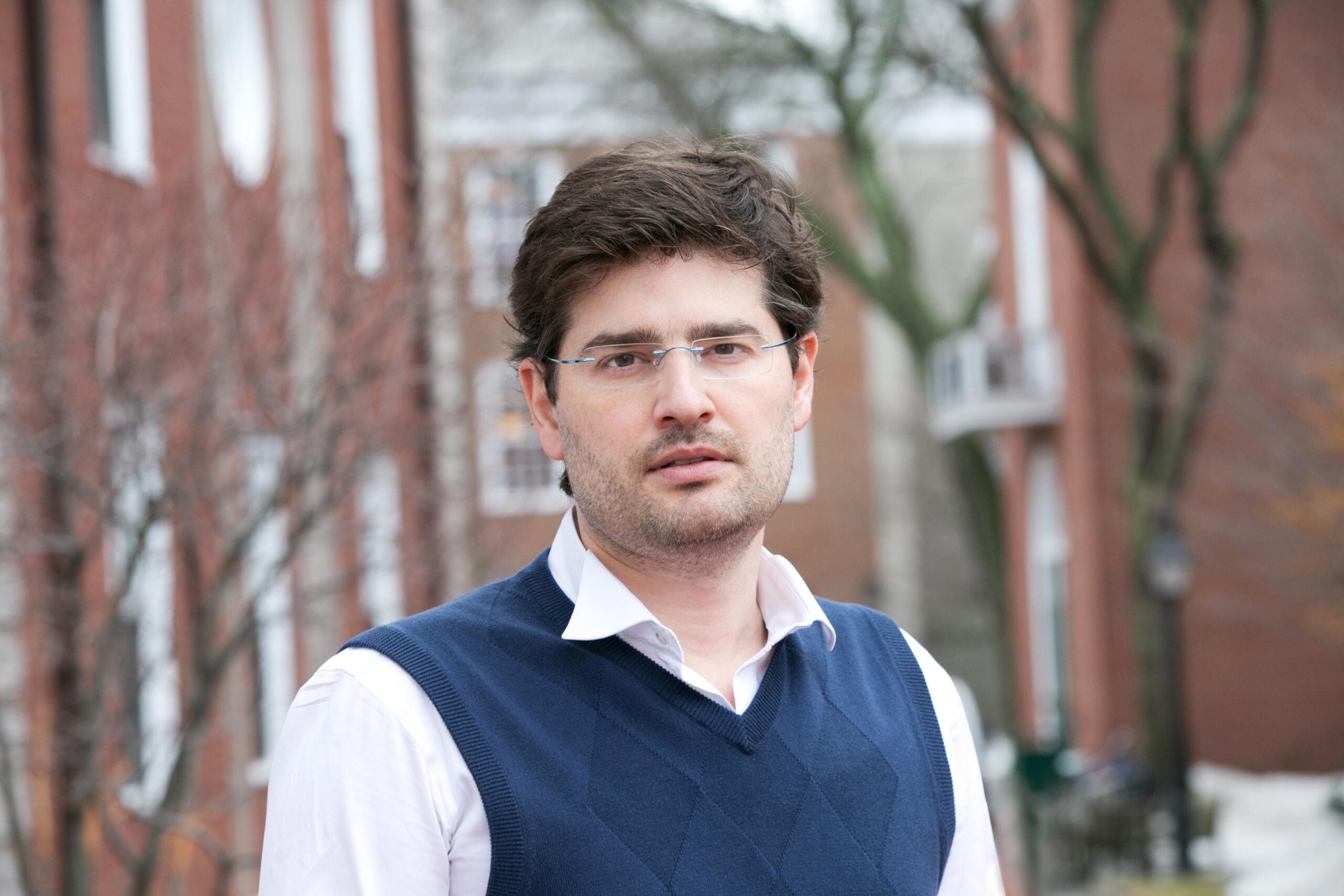A weekly seminar featuring guest speakers presenting cutting-edge research in development economics. Please note that the series this semester will be in person. All seminars will take place from 1:00-2:15 on Thursdays in ICC 550.
Dennis Egger

Oxford University
February 20, 2025
Slack and Economic Development
Michael Walker (University of California, Berkeley)
Nachiket Shah (University of California, Berkeley)
Edward Miguel (University of California, Berkeley)
Felix Soliman (University of Zurich)
Tilman Graff (Harvard University)
Dennis Egger (Oxford University)
Slack — the underutilization of factors of production — varies systematically with economic development. Using novel and detailed measures of the utilization of labor and capital from a large representative sample of firms in rural and urban Kenya, we show that utilization is increasing in firm size, market access, and economic activity. We present a model of firm capacity choice where indivisibility in at least one input is a key driver of slack. We embed the model in spatial general equilibrium, with features characteristic of low-income settings — including many small firms and high transport costs — and show that it rationalizes both the endogenous emergence of slack in steady-state and elastic aggregate supply curves. We empirically validate model predictions using reduced-form estimates of the general equilibrium effects of cash transfers from a large-scale RCT in Kenya. The parsimonious model replicates much of the experimental evidence, predicting a large real multiplier of 1.5, driven by expansion in low-utilization sectors and firms, and limited average price inflation. Counterfactual analyses indicate that multipliers are likely to be meaningfully smaller in lower slack settings, such as urban areas. We use the model to revisit the estimation of spatial spillovers in clustered RCTs and uncover non-trivial ‘missing intercept’ effects on income and inflation. Additionally, we innovate methodologically by pre-registering key elements of model estimation and validation. The findings suggest that input indivisibilities and slack are key features of developing country settings, and are quantitatively important for macroeconomic dynamics and policies.
Lucia Corno

Cattolica University and LEAP
February 27, 2025
Norm Replacement and Information. An Experiment on Ending Female Genital Cutting
Lucia Corno (Cattolica University)
Eliana La Ferrara (Harvard Kennedy School)
Female Genital Cutting (FGC) is a deeply harmful practice with severe consequences for women’s health, human capital accumulation, and psychological well-being. This paper evaluates the effectiveness of two interventions designed to reduce the incidence of FGC among adolescent girls in Sierra Leone, where FGC is integral to the traditional initiation ceremony known as Bondo, symbolizing a girl’s transition to womanhood. We randomly assigned 150 villages to three experimental arms: (i) a control group; (ii) an Information arm, which facilitated community discussions about the ”costs” associated with FGC, emphasizing why it should be abandoned; and (iii) a Norm-replacement arm, aimed at substituting the traditional ritual with an alternative that does not involve cutting (“Bondo without cutting”), focusing on how to abandon FGC. We measured girls’ FGC status both through maternal reports and clinical observations by healthcare professionals. Three years after the intervention, both treatments resulted in a 23%-25% reduction in the likelihood of FGC among girls aged 10-18. Mechanism analysis reveals that the Information arm improved awareness of health risks, while the Norm-replacement arm increased acceptance of alternative rituals. Both interventions also led to a modest reduction in social pressure, as reflected in second-order beliefs. These findings highlight the importance of culturally sensitive, grassroots approaches to transforming entrenched harmful social norms.

Spring Break
March 6, 2025
Stelios Michalopoulos
Uprootedness, Human Capital, and Skill Transferability
Stelios Michalopoulos (Brown University)
Elie Murard (University of Trento)
Elias Papaioannou (London Business School)
Seyhun Orcan Sakalli (King’s College London)
More than a century has passed since the abrupt exodus of 1.2 million Greek Orthodox from Anatolia and their arrival in Greece, a transformative event for the country’s social and demo- graphic landscape. Today, one in three Greeks reports a refugee background. While its historical significance is well-documented, its short-, medium-, and long-term impact on human capital accu- mulation remains unexplored. How did forced displacement shape the educational trajectories of the uprooted and their offspring? Did refugees invest in portable skills to respond to uncertainty, or did they struggle to catch up with the autochthonous? To address these questions, we trace the educational investments of refugees and their descendants over the last 100 years, leveraging gran- ular census data and a comprehensive mapping of both their origins in Anatolia and settlements in Greece. The analysis provides compelling support for the uprootedness hypothesis. Though initially lagging, refugees settling in the Greek countryside eventually surpassed nearby natives’ educational attainment. Their university choices also diverged with refugees’ lineages favoring de- grees transferable beyond the Greek labor market, such as engineering and medicine, and natives specializing in law and other fields with a strong home bias. Exploring additional mechanisms reveals the critical role of linguistic barriers and economic conditions at the destination, as opposed to origin and background characteristics. The widespread educational gains of refugees and their descendants over three generations offer some hope that the ongoing surge of forced displacement, despite its tragedy, if properly addressed by the international community, can be a backbone of economic resilience for the affected communities.
Anne Karing

University of Chicago
March 20, 2025
Optimal Policy with Social Image Concerns: Experimental Evidence from Deworming
Anne Karing
Karim Naguib
Ed Jee
Access to health services is often viewed as primarily a logistic issue, without considering the role of social norms. Economic theory suggests social image concerns interact with logistical factors like distance and observability, acting as a social multiplier to strengthen or weaken their impact. We examine this interaction in a large-scale field experiment in Kenya, randomly assigning communities to deworming treatment locations at varying travel distances and introducing verifiable signals for adults to broadcast their deworming status. We find that a one-kilometer increase in distance reduces treatment take-up by 16 percentage points in the absence of signals, but this negative effect is mitigated by 6 percentage points when signaling is facilitated. Using a structural model, we show that distance not only changes the private cost of deworming but also alters the observability of actions and equilibrium beliefs about who deworms, thereby affecting social image returns. Combining our model estimates with geographic data, we demonstrate that by introducing a signal, travel distances can be increased by 11% without reducing take-up, highlighting an effective lever for expanding access to health services.
Gautam Rao

UC Berkeley
March 27, 2025
Policymaker Networks and the Diffusion of Policy Innovation: Causal Evidence from Brazil
Gautam Rao (UC Berkeley)
Ines Baldin (UC Davis)
Jonas Hjort (UCL)
Diana Moreira (UC Davis)
Juan Francisco Santini (World Bank)
We elicit policymaker networks using surveys of 829 mayors in Brazil. We find that the average mayor reports talking regularly to six other mayors. More experienced and more educated mayors have more network connections. Geographic proximity is the strongest predictor of two mayors being connected to each other, with shared party membership and ideological similarity playing a statistically significant but quantitatively much smaller role. We next turn to reanalyzing data from a large-scale field experiment which randomly selected mayors to receive research findings about the efficacy of reminder letters in increasing tax compliance. The original study had found significant direct effects on policy adoption in the treated municipalities two years later. Using the findings from the social network analysis, we test for diffusion or spillovers of this treatment to other municipalities. We find evidence of large and significant spillovers in policy adoption.
Denni Tommasi

University of Bologna
April 3, 2025
Quality upgrading in the street food market: are better infrastructure and training sufficient?
Caitlin Brown
Denni Tommasi
We study quality upgrading in the informal sector through two field experiments with consumers and street food vendors in Kolkata, India. In the first experiment, we measure consumer willingness to pay (WTP) for improved hygiene and find that consumers are willing to pay substantial premiums for visibly cleaner kiosks. In the second experiment, we test whether providing vendors with highly visible sanitation equipment and targeted training leads to sustained improvements in food safety practices. While treated vendors adopt the equipment and initially demonstrate improved hygiene, maintenance of food safety practices declines over time. Despite higher profits driven by increased customer demand, vendors do not sustain hygiene improvements in the long run. We document that restrictive market norms—such as strong price coordination and informal rules discouraging differentiation—limit vendors’ ability to charge higher prices. Additionally, widespread concerns over theft and the perceived risk of losing subsidized equipment reduce incentives to invest in sustained food safety improvements. Our findings align with a moral hazard framework in which the net profitability of cleanliness remains low, despite temporary financial incentives.
Selecting Experimental Sites for External Validity
Michael Gechter
Keisuke Hirano
Jean Lee
Mahreen Mahmud
Orville Mondal
Jonathan Morduch
Saravana Ravindran
Abu S. Shonchoy
Policy decisions often depend on evidence generated elsewhere. We take a Bayesian decision-theoretic approach to choosing where to experiment to optimize external validity. We frame external validity through a policy lens, developing a prior specification for the joint distribution of site-level treatment effects using a microeconometric structural model and allowing for other sources of heterogeneity. With data from South Asia, we show that, relative to basing policies on experiments in optimal sites, large efficiency losses result from instead using evidence from randomly-selected sites or, conversely, from sites with the largest expected treatment effects.

Easter Break
April 17, 2025
Selim Gulesci

Trinity College Dublin
April 24, 2025
Liquidity, Business Development and Gender: Evidence from Credit Contracts
Selim Gulesci
Francesco Loiacono
Andreas Madestam
Miri Stryjan
A growing body of research demonstrates that standard microcredit products with strict borrowing limits and rigid repayment plans restrict borrowers’ ability to invest in their businesses. In this paper, we study which particular constraint(s) limit standard contracts’ ability to support firm growth and how these vary by the borrower’s gender. We designed and implemented a field experiment where entrepreneurs borrowing from a major Ugandan lender were randomly offered contracts which vary liquidity available to them at different points during their loan cycle. We find that having access to more flexible liquidity results in higher firm profits after five years. By contrast, providing upfront liquidity via cash transfers do not affect firm outcomes. The effects vary considerably by borrowers’ gender. Male borrowers hire more workers and generate higher profits under flexible repayment contracts, while we do not find any significant effects on firm outcomes for female borrowers. Instead, female borrowers increase household consumption and reduce consumption volatility during the loan cycle. Our findings suggest that for male borrowers, saving and insurance constraints are key barriers that limit the ability of credit contracts to support firm growth, while female borrowers are affected by household-related constraints.

